| Lucas Hardwick |
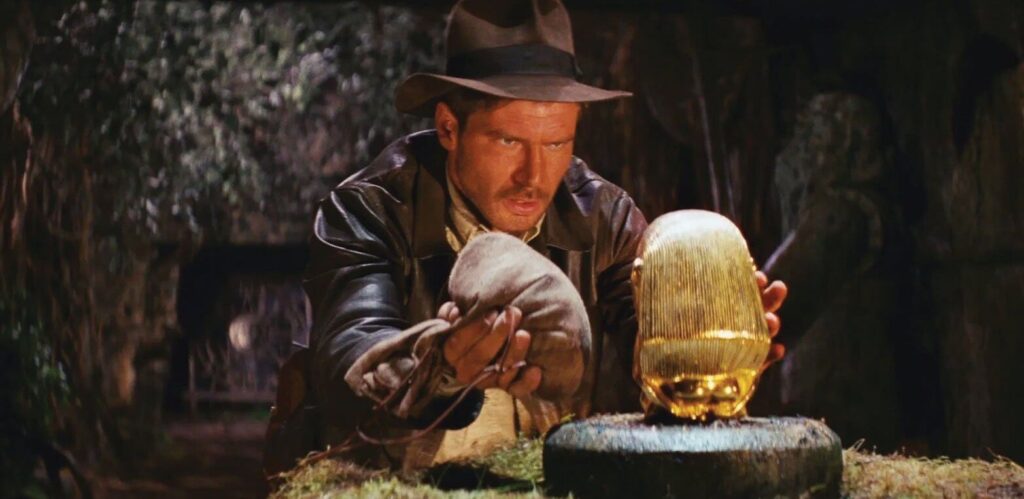
Raiders of the Lost Ark plays in glorious 35mm at the Trylon Cinema from Friday, July 11th, through Sunday, July 13th. For tickets, showtimes, and other series information, visit trylon.org.
The views expressed in the article regarding Doritos, flavored booze, and India Pale Ales do not reflect those of the (volunteer) staff of Trylon Cinema, Perisphere Blog, most of Portland, Austin, Louisville, Jeremy S. from Junior year 21st Century Class at Hopkins County Central High class of ’99, or the greater Minneapolis-St. Paul area.
Since when did our taste buds demand that everything taste like anything but what it is we’re actually stuffing our faces with? One should look no further than the Dorito aisle at their local Walmart to know exactly what I’m talking about.
Depending on the bandwidth of your test market, there are currently no less than 10 flavors of Doritos to transfix consumers into a benumbed state of option paralysis with a lineup of names that sound like they’re chosen by the 11th grade Fortnite champ moonlighting at the Game Stop located between the Crumbl Cookie and the vape shop in the strip mall on your town’s main drag.
Somewhere after “Cool Ranch” but before “Spicy Sweet Chili” things get confusing and the more exotic Doritos just start to taste like a honey mustard variation of “Sweet and Tangy BBQ,”—I’m talkin’ to you, “Golden Sriracha”—or you’re exploited with some untasteable variety of “Flamin’ Hot” that’s dusted with the essence an insanely Scoville-scored pepper that’s named after something to do with death that nobody asked for in the first place. I, however, contend that “Late Night Taco” is the newest flavor that dares to grow the Dorito family beyond “Limited Time” offerings with its hyper-accurate umami of microwave-warmed, withered taco lettuce that satisfies those otherwise dormant cigarette cravings mysteriously driving you to pillage your cabinets at 2:00 am for delectables that simply just won’t do.
Don’t even get me started on the endless options of chewing gum flavors or the “infused” epidemic infesting coffees, teas, and precious bourbons and vodkas altering their finely crafted natural states into abominations like barbecue-laced whiskey with post-hipster renaissance names like Kurvball. Lest we forget the increasingly popular peanut butter whiskey Skewball which tastes exactly like peanut butter. Combine it with blackberry Crown Royal, a dash of Angostura, and a splash of sparkling white wine and you got some kind of PB&J atrocity called “The Sack Lunch” that costs $14 at your local rooftop bar. And everyone sits around sipping their dinner, perusing the drink menu saying stuff like, “You can’t even taste the alcohol! I want to try the ‘Kum ba ya’; it tastes like s’mores!”
There’s also the “IPA guy.” Everyone knows an “IPA guy”—you know that guy who only drinks overly-hopped beers and will never admit that IPAs taste like earwax-infused model glue but they have a 9% alcohol content, so that’s cool, right? “It’s a sipping beer,” they like to say, sounding refined, avoiding admission that their preferred beer tastes like crap. The IPA may be the only excuse to make something taste like anything but what it is, which puts us right smack dab in the obnoxious realm of craft beer.
In Asheville, North Carolina, after a day of hiking the Mount Pisgah Trail and leafing through record shops, tourists can cap their day by ticking off breweries on the Ale Trail. With over 200 craft beers to choose from across all of North Carolina, the Ale Trail gives visitors the opportunity to be the beer lovers they knew they never were, serving up flavor profiles that fit even the choosiest and most peripheral beer drinkers.
The most popular and fiscally efficient option for adventure is to shell out $16 for a beer flight of five different flavors of your choosing at five ounces each. This is mostly so your date or spouse or whoever you’re sharing with can hate four of them and sip most of the fifth, leaving you to get your money’s worth by choking down the Blueberry Pancake Chocolate Donut Stout and the 12% Hickory Maple Butterscotch Banana infused Dragon’s Milk after the Jalapeño Pineapple and Pear essenced Sour sets your guts on fire and the Birthday Cake Bourbon Barrel Extra-Hopped IPA makes you physically ill. But, oh, how fascinating that beer can take on such a diverse array of flavors to make you FORGET THAT YOU’RE DRINKING BEER!
And now you’re officially part of the craft beer scene. At least that’s how it happened for me.
And then I went to Prague.
Known to some as the Beer Capital of the World, this singular moniker is what sold Prague for me as a honeymoon destination back in March of 2020. Yes, that March of 2020, you know the one where the world was ravaged by the raging pandemic that had us all washing our mail and sanitizing our hands to a crisp. That’s another story better suited for a double-feature of Threads and Daughters of Darkness, though.
The Czech Republic drinks more beer than any other place in the world, consuming 128 liters per capita per year. A world-renowned “beer capital” is sure to have an endless variety of beer options, right?
Wrongo, chongo!
After amusing yourself on a visit to the Sex Machines Museum and a sprawling tour of St. Vitus Cathedral, take an evening stroll through Malá Strana back across the Charles Bridge into Nové Město and visit any of the pubs, restaurants, or ale houses and you’ll find a handful of beer labels. Names like Pilsner Urquell, Kozel, and Staropramen populate the drink menus, but what you’ll find most consistently no matter what brand, is beer in the Beer Capital of the World, at around $2 a pint—making it cheaper than water—and consumed at a rate that surpasses the barflies of Milwaukee, Boston, and Chicago, is it essentially comes in two varieties: light and dark. No bloody Dragon’s Milks or Stouts or Sours, Saisons, Imperials, or Cream Ales, and there sure as hell are absolutely no IPAs; just honest to God, straightforward Beer.
Unlike the American propensity to get down to drinking as quickly as possible, the barkeeps of Prague implore drinkers to take their time, pouring a tall foam head coercing you to savor the moment and let all the gasses air out to make your drinking experience less filling, thereby less bloating, and more enticing to keep the party going, creating a populace that consumes more beer per person than anywhere else in the world. It’s crisp. It’s refreshing. It’s perfection.
Meanwhile, back in the U.S, in his 2004 New Yorker article “The Ketchup Conundrum,” history revisionist Malcolm Gladwell posits that ketchup is the one food that cannot be improved upon and is perfect exactly as it is. While numerous varieties of mustard line the condiment aisles in grocery stores across the nation, plain ol’ tomato ketchup remains a reliable mainstay that earns up to nearly $40 billion a year existing exactly as it essentially always has.
All these attempts at flavor and variety are an attempt at achieving perfection, when in many cases, the perfection was there all along. Nacho Cheese Doritos will always satisfy. A simple bourbon does exactly as it was ever meant to do. And beer in its purest form, as God intended, is when it’s most worthwhile, and at 128 liters per belly per year, who are the 11 million people of the Czech Republic to disagree?
And speaking of God, The Man Upstairs has always been a stickler for perfection. After that momentous, existential fumble in the Garden of Eden, The Almighty has expected us to work at being the best we can be but not without a little help along the way, starting, ostensibly, when Moses descended Mount Sinai after his chat with the Burning Bush that bestowed upon him those immortal stone tablets outlining the stipulations of a perfect existence: The Ten Commandments.
While not so concerned with perfection as a society because they believed they themselves were a super-race, Adolf Hitler and his Nazi goons became interested in The Ten Commandments for other reasons. “Hitler’s a nut on the subject. He’s crazy. He’s obsessed with the occult,” says Army Intelligence Officer Major Eaton (William Hootkins) to renowned archaeologist Dr. Henry “Indiana” Jones (Harrison Ford) in a plea for Indy to pull his well-connected resources and intercept the Führer’s search for the Ark of the Covenant.
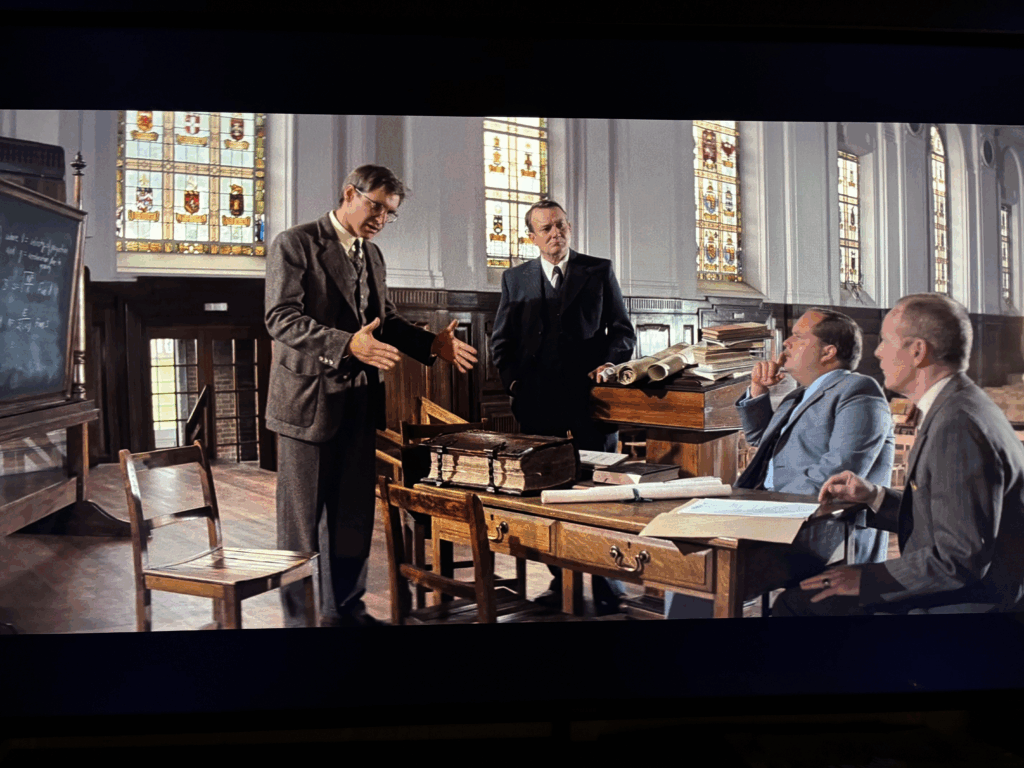
“Didn’t any of you guys ever go to Sunday School?”
And so the righteous cause to prevent a fascist super-power from harnessing the divine supernatural force of God and the search for the guiding postulates of a perfect existence stored in a biblical shipping container become the driving force of a perfect film in Steven Spielberg’s 1981 action-adventure masterpiece Raiders of the Lost Ark.
Before we get started, let’s get one thing straight: whatever streaming service you’re plunking down $24.99 a month for likely has this film listed as Indiana Jones and the Raiders of the Lost Ark, so as perfection goes, they got it wrong right off the bat. It’s Raiders of the Lost Ark, always has been, always will be, and don’t let anyone tell you different, forever and ever, Amen.
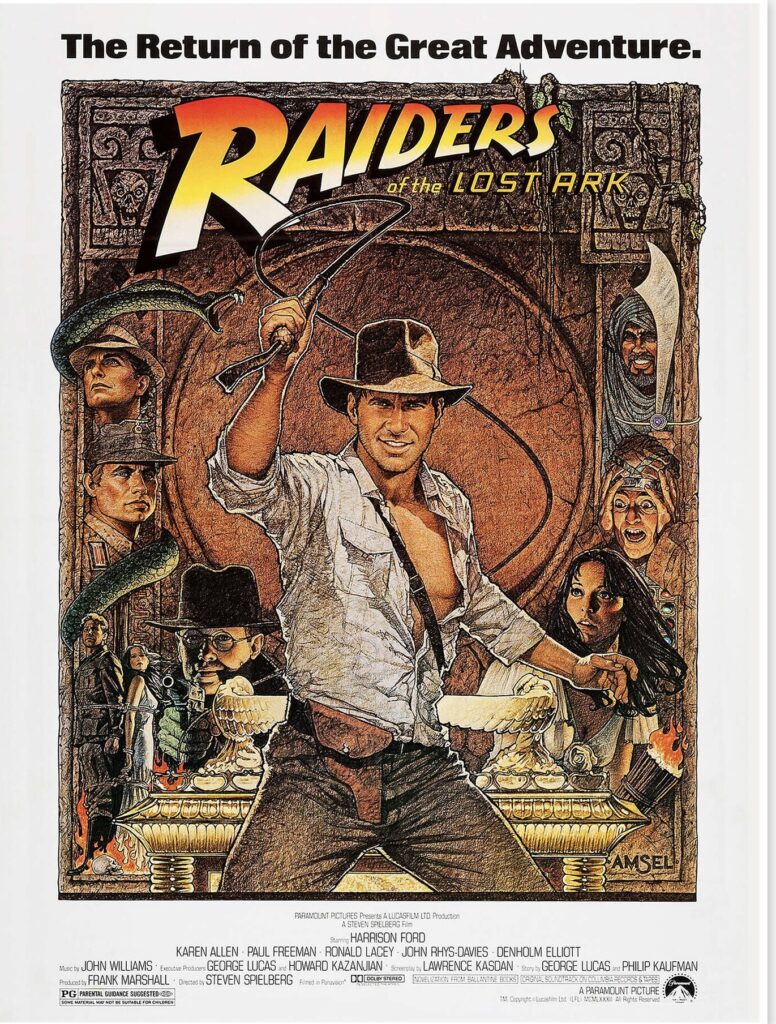
Not much can really be said about Raiders of the Lost Ark that hasn’t already been said by just about everyone who’s essayed a profound thought on the film since its release. It’s a blockbuster mainstay that has thrilled audiences for nearly 45 years and Spielberg’s timeless execution makes the film date-proof to the point that pretty much the only thing that suggests it was made after the 1930s is that it’s in color.
But beyond its exhilarating sense of swashbuckling adventure, a number of more universal distinctions classify Raiders of the Lost Ark as what I consider to be “A Perfect Film.” That’s why I’ve worked tirelessly over the past three and a half hours to present before you in less than stone tablet fashion, yay verily, The Ten Commandments of a Perfect Film.
Commandment I: Thou Must Be Entertaining
The worst sin a film can commit is to be boring, and anyone who’s seen a Jean-Luc Godard film knows that most of those flicks are destined for Cinema Hell. But beyond thrill-a-minute action, special effects, and a plot to keep you on the edge of your seat, this principle is best showcased by a film’s inherent nature to move along.
From its mysterious, almost silent opening sequence as Indy thwarts several not-so-primitive booby traps searching for the Chachapoyan Fertility Idol, to the curious final moments revealing a secret government warehouse filled with crates where the Ark of the Covenant is tucked away for eternity next to thousands of other peculiar relics, Raiders never fails to hold our interest. Even the chattiest moments are charmed by Harrison Ford’s portrayal of Indy, and when he’s not cracking wise and just being handsome, we have the pleasure of witnessing a cadre of villains chewing up scenes rattling off their fiendish designs.
Raiders’ slowest occasions usually involve Indy’s adversary, rival archeologist René Belloq (Paul Freeman) but even then the exchange is dripping with wicked dialogue, and the encounter never lingers too long.
Commandment II: Thou Shalt Have No Other Shots Before Me
In case anyone has forgotten, film is a visual medium, the idea is to show more than tell or tell by showing. We didn’t pay $12 a person to come and just listen to a 40 foot screen, and when something is in the business of being seen, it needs look pretty fucking cool as much as possible.
Raiders cleverly kicks off by spoofing the Paramount logo, as the iconic mountaintop dissolves into the image of some mountain in South America. This immediately immerses us into the two hours of pure escapism ahead. It reminds us of something we’d think to do as children, and it tells us that what we’re seeing is real but isn’t exactly reality. This delightful visual cue is repeated in Indiana Jones and the Last Crusade and The Kingdom of the Crystal Skull.
The film’s action is comic book, and its dramatic moments look like Hollywood’s golden age. I don’t know when everyone decided that the shaky cam stuff made a fight scene better; probably around the time of the Bourne movies, but in Raiders you actually see Indy throw his punches, and they’re always haymakers.
The first time Indy slings his iconic bullwhip, the shots move quick, playing like a sequence of frames from an adventure comic. Up until that moment, Indy is in shadow, lurking through South American jungle, when he’s required to intervene as one of his guides draws a weapon. Indy lashes his whip and steps into the light of the frame, at last revealing the rugged countenance of Harrison Ford looking almost as good as he’s ever looked (though, he looked his very best ever in Temple of Doom, in my opinion).
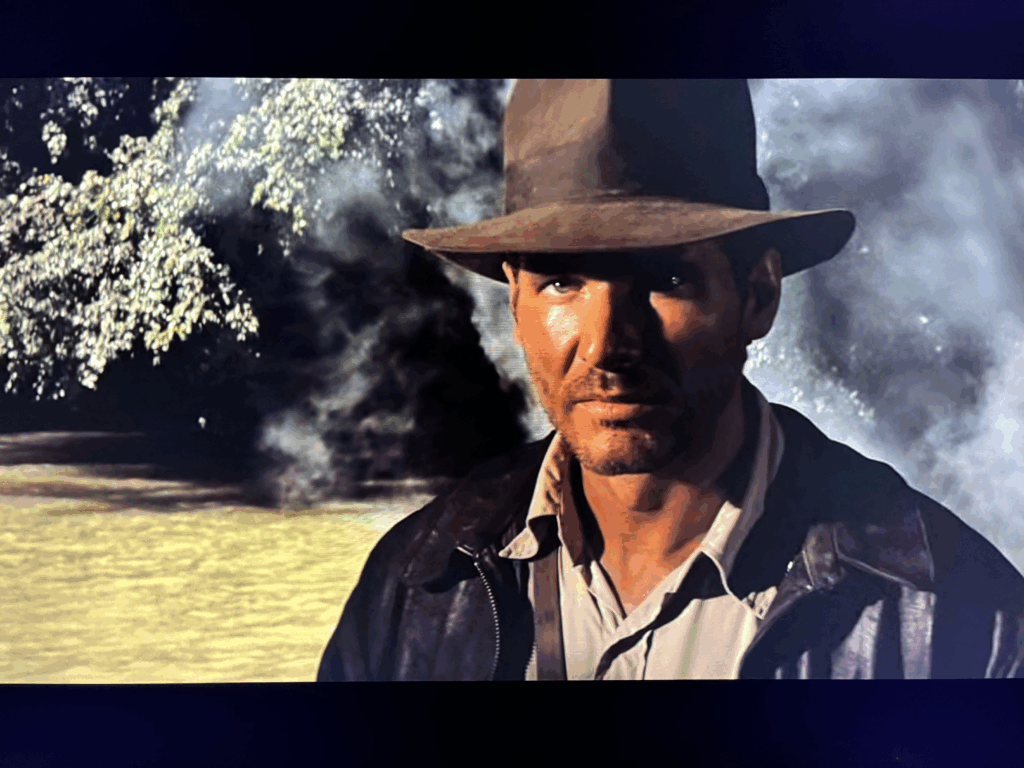
Dreamy.
When Indy visits Marion Ravenwood (Karen Allen) at her bar in Tibet, in a play from classic Hollywood noir, he’s first revealed as a looming shadow on the wall, his fedora in silhouette letting us and Marion know just exactly who has arrived. The visual treats never stop, and are imperative to keeping us engaged.
Commandment III: Thou Must Have Hummable Music
Thanks to Hans Zimmer and his scores for a run of Christopher Nolan films, film scores these days are little more than obnoxious tones and “soundscapes.” What the hell even is a soundscape and when was the last time you saw a movie that you 1) wanted to hum its score and 2) could actually hum it? The blockbusters of the past 20 years or so are afflicted with giant bass-toned BBBBRRRRAAAAAAAAPPPPPs in the same register as grandad farts that I guess are supposed to make us feel something colossally ominous is happening. It was cute the first few times.
Composer John Williams had three straight bangers in a row: Star Wars, Superman, and the “Raiders March,” and if you hum ‘em just right, you can string ‘em together. Let’s not forget Jaws, Close Encounters of the Third Kind, and the “Imperial March” from The Empire Strikes Back. Iconic. John Williams is as much responsible for making us believe a man can fly as the special effects themselves in Superman: The Movie, and in Raiders of the Lost Ark, he’s at least half of the adventure.
Commandment IV: Thou Shalt Have No Miscast Actors
You’ve seen the movie. Look no further than Ronald Lacey as Major Toht as the defining archetype of a Nazi goon and tell me I’m wrong.
Commandment V: Thine Characters Shalt Not Have Nothing to Do
Not a soul is wasted in this film. Even the parts with the least screen time—the kid preparing the dates that sets up Indy nearly being poisoned or Katanga (George Harris) the captain of the boat that takes Indy and company out to the German U-boat carrying the Ark—every single character is necessary and introduced as fully formed. In every instance we know within seconds who each person is without wasting precious screen time with arduous and pesky overwrought exposition.
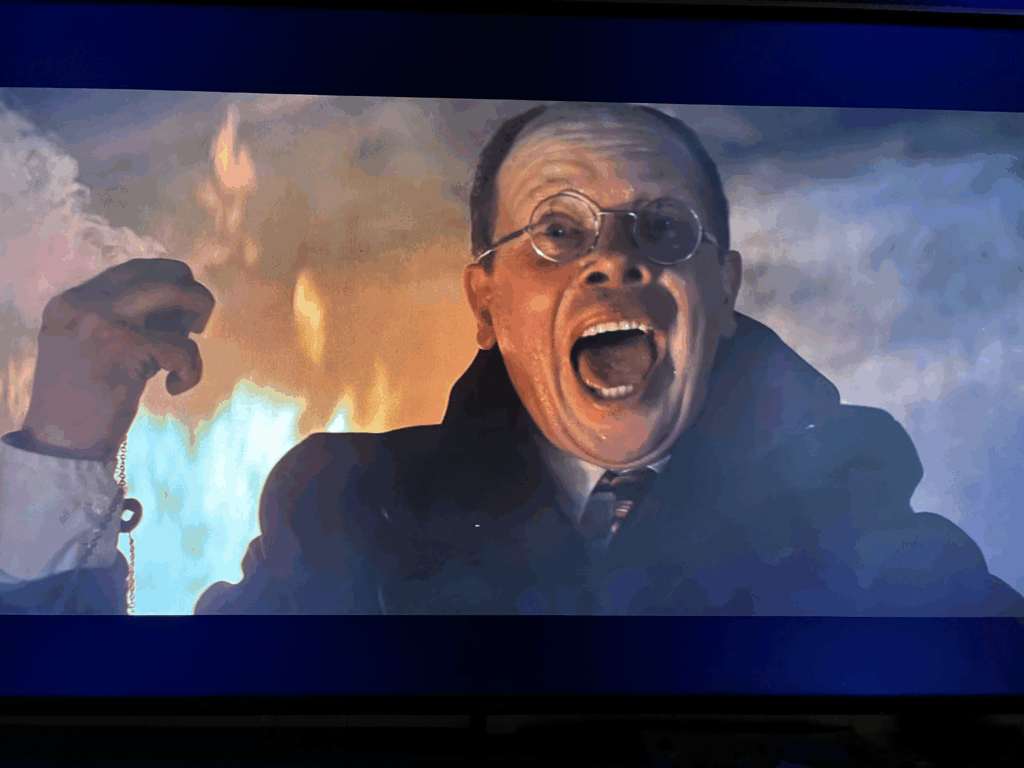
Hot to Toht.
Characters with jobs means an airtight plot. When squirmy Major Toht accidentally brands his hand grabbing for the Headpiece to the Staff of Ra from a pile of hot ash with the inscription that reveals the secrets to the Well of Souls, it pays off in a big way later when Indy and Sallah (John Rhys-Davies) are trying to figure out how the Nazis know exactly where to dig for the Well in Egypt. Indy and Sallah don’t know how this is possible, but we do. Screenwriter Larry Kasdan doubles down on the tiny but requisite moment when it’s revealed that the Nazis are missing more key inscription on the reverse side of the Headpiece. Why? Because of the one side that was branded onto Toht’s palm. It’s a neat little tricky plot conceit making Toht essential to moving the plot along when he would otherwise simply be the film’s resident creep.
Commandment VI: Thou Must Be Timeless
I hear people all the time say stupid stuff like, “I don’t watch black and white movies” and “I don’t like any movies made before 2006.” (not kidding; I actually heard some idiot say that once). Well, guess what, dummies, I dare you to watch Raiders of the Lost Ark and tell me that you can’t prove that it wasn’t made yesterday or that it wasn’t at least made in the 1950s. Aside from it being in color and a few remarkable special effects near the end, Raiders is essentially an undated movie and could be just as enjoyed by audiences of the era it occurs in as much as audiences today without anyone finding a tell that reveals anything about the era in which it was made.
Commandment VII: Thou Must Be Cinematic
You say, “What the hell does that even mean, Lucas?” It means all elements of the film work cohesively to yield a complete experience. The film’s visual, performance, musical, and storytelling elements work in unison to immerse the audience into its reality. Cinema. Duh.
You can have “cinematic” moments alone in your car, particularly when you’ve just had your heart broken and it’s just about to rain, and Nick Cave and The Bad Seeds’ “People Ain’t No Good” pops up on your playlist.
The point is, when you got that Johnny Williams score working with comic book action and a character like Indiana Jones, you’re no longer in the real world, which is the point of going to the movies in the first place.
Commandment VIII: Thou Must Be Well-Paced
This kinda calls back to being entertaining.
Even The Almighty is known to repeat himself from time to time.
Commandment IX: Might Not But Wot Exactly What It Is
The second biggest sin a movie can commit is taking itself too seriously like all those Zack Snyder superhero movies that came out a few years ago.
The Italians have remained the gold standard for self-awareness ever since those nutty giallo flicks in the 1970s where faceless black-gloved killers run around hacking up pretty girls with kitchen knives until it’s revealed in the final seconds that the killer was the little crippled girl we saw for 20 seconds in the first act, and somehow it always makes sense. A film’s self-awareness is indispensable to uncovering its charming heart of gold.
Raiders of the Lost Ark is real, but it’s not reality. Since when did respectable college professors of archeology carry bullwhips and wear leather bomber jackets and fedoras on desert expeditions? Since never, but it looks really damn cool and Raiders knows it. Extrapolate that, and you’ll believe whatever this movie tells you.
Commandment X: Thou Must Punch Nazis
My film studies instructor, Eric Braysmith at the University of Southern Indiana used to say, “There’s no such thing as a bad film.” Well, the jury’s still out on that for most of us, but what he was getting at is that no filmmaker sets out to make a piece of shit and that while we may not always connect with what we’re watching, the intent is always hopeful that we will.
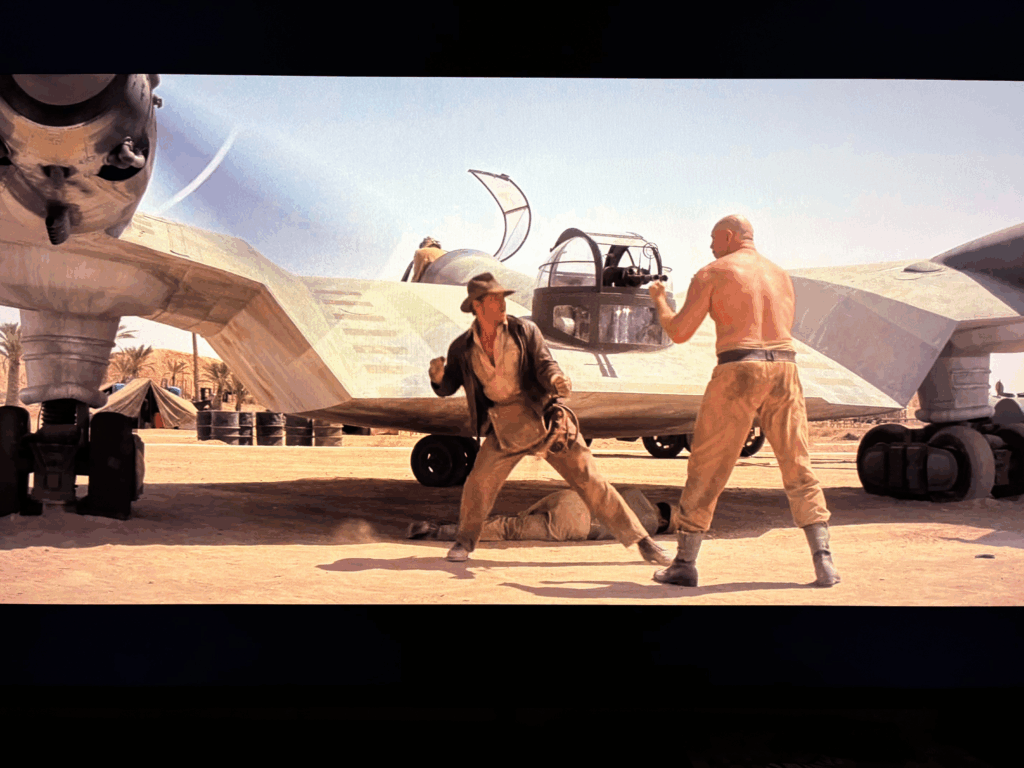
Making the world a better place.
Indiana Jones does his share of actually pummeling Nazis—and we love to see it—but more than that, Raiders of the Lost Ark figuratively punches them by doing what most movies and art and music and books intend to do, and that is make the world a better place. I mean, is anyone mad about seeing an Indiana Jones film? If you are, then you’re part of the problem.
You say, “Well, what about all those sad Japanese movies like Hiroshima that are about being annihilated by the atomic bomb?” Movies with bleak stories especially make the world a better place by making us feel like shit because they remind us that we’re capable of being shitty, and so maybe let’s not be.
Unless you’re making snuff films, this Commandment is pretty tough to screw up.
* * *
The old saying goes, “perfect is the enemy of good” and in the case of Doritos and beer, I couldn’t agree more. It seems the more we as a society hack away at something that is just fine the way it is, the more confounding it gets. Perhaps even kind of like this 3,000+ word essay you’ve just read, but like any great adventure, sometimes you have to take a journey to get where you’re going.
And in the spirit of adventure and Doritos and Beer, Raiders of the Lost Ark kicked off a franchise that sought to recapture the perfection of its origins. While the remaining Indiana Jones films fulfill a handful of the aforementioned Commandments, they never quite crack the entire code a second time. The pursuit of perfection, however, is one of the charming, precious little aspects of humanity that endear us amongst the cosmos. The idea of tinkering with Doritos and beer and ketchup and bourbon and action-adventure heroes to make the world a better place is really kind of perfect isn’t it.
Edited by Olga Tchepikova-Treon
